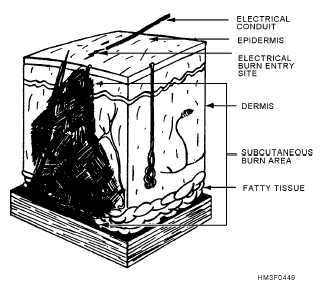may cause injuries that are generally referred to as
chemical burns. For the most part, these injuries are
not caused by heat but by direct chemical destruction
of body tissues. Areas most often affected are the
extremities, mouth, and eyes. Alkali burns are usually
more serious than acid burns because alkalies
penetrate deeper and burn longer.
When such burns occur, the following emergency
procedures must be carried out immediately:
1. Quickly flush the area with large amounts of
water, using a shower or hose, if available. Do
not apply water too forcefully. Flood the area
while the clothing (including shoes and socks) is
being removed and continue often removal.
NOTE: There are two exceptions to the
above: (1) In alkali burns caused by dry lime,
the mixing of water and lime creates a very
corrosive substance.
Dry lime should be
brushed away from the skin and clothing,
unless large amounts of water are available for
rapid and complete flushing. (2) In acid burns
caused by phenol (carbolic acid), wash the
affected area with alcohol because phenol is
not water soluble; then wash with water. If
alcohol is not available, flushing with water is
better than no treatment at all.
2. After thorough washing, neutralize any
chemical remaining on the affected area.
WARNING: DO NOT attempt to neutralize a
chemical unless you know exactly what it is
and what substance will neutralize it. Further
damage may be done by a neutralizing agent
that is too strong or incorrect.
For acid burns, make a solution of 1 teaspoon of
baking soda to a pint of water and flush it over
the affected area. For alkali burns, mix 1 or 2
teaspoons of vinegar to a pint of water and flush
it over the affected area.
3. Flush the area again with water and gently pat
dry with a sterile gauze. Do not rub the area.
4. Transport the victim to a medical treatment
facility.
When treating chemical burns to the eye, the one
and only emergency treatment is to flush the eye(s)
immediately with large amounts of water or a sterile
saline solution. Irrigate acid burns to the eyes for at
least 5 to 10 minutes with at least 2000 ml of water.
Irrigate alkali burns to the eyes for at least 20 minutes.
Because of the intense pain, the victim may be unable
to open the eyes. If this occurs, hold the eyelids apart
so that water can flow across the eye.
A drinking fountain or field “water buffalo” may
be used to supply a steady stream of water. Hold the
victim’s head in a position that allows water to flow
from the inside corner of the eye toward the outside.
Do not allow the water to fall directly on the eye, and
do not use greater force than is necessary to keep the
water flowing across the eye.
CAUTION: Never use any chemical antidotes
such as baking soda or alcohol in treating
burns of the eye, and do not try to neutralize
chemical agents.
After thorough irrigation, loosely cover both eyes
with a clean dressing. This prevents further damage by
decreasing eye movement.
The aftercare for all chemical burns is similar to
that for thermal burns: Cover the affected area and get
the victim to a medical treatment facility as soon as
possible.
WHITE PHOSPHORUS BURNS
A special category of burns that may affect
military personnel in a wartime or training situation is
that caused by exposure of white phosphorus (WP or
Willy Peter).
First aid for this type of burn is
4-59
Figure 4-49.—Electrical burns.


